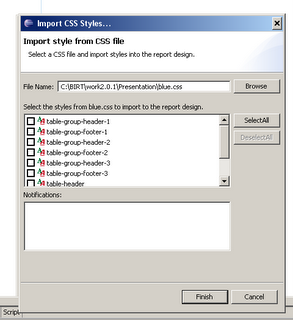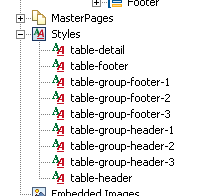In general, I have been working on proof of concept technical details in my BIRT reports. I figured that if I could get it to work, someone else would make it look good (typical developer). At the MySql conference I had the opportunity to present to the MySql users about BIRT, and I wanted my reports to look good. Not only that I wanted to make them look good quickly.
So I have a simple tabular report that looks like this:
What I would like to do is format it to make it distinctive. I also want to do that in as few operations as possible. The slowest way that I could do it would be to go through the property editor setting properties on each of the controls.
Clearly the property editor works, but it involves a lot of mouse clicks. So the next approach would be to create Styles and apply the style to each row. This technique is significantly faster, but it is still not fast enough.
What I really want to do is just apply styles using Cascading Style Sheets. If you select the table element you will see that under Style one of the options is Import CSS. Seems like this would be a reasonable selection.

When you select this option, it brings you to a menu which has you select a CSS file and then gives you an option to select certain elements within the style sheet. Doing this will add style to your report as shown in the outline view.
Now if you do this, you can select each element (row, cell, etc.) and apply a style from your list of styles, but the styles that you import will not automatically be applied to your tables. This is because that the BIRT elements have standard names associated with each slot. In order for your style sheets to automatically be applied to elements in your report you have to use these standard names.
The only place I found this documented was in the PredefineStyle class of the model.metadata. I grabbed the JavaDoc comment here for your review:
BIRT defines a fixed set of predefined styles. These style correspond to certain report elements, or element slots. For example, there is a style * for chart, for list headers, for table footers and so on.
The set of predefined styles is part of the element design and is fixed by the development team. Fixed properties of predefined styles includes the internal name and display name. However, the property values for the style are set in a design or template and are part of the design itself.
This class represents the invariant part of the predefined styles. It is used to create a style element within a new design.
Note that predefined styles are identified with an internal name of element name, slot name or their combination. For example, to select a list, use the "list" style. To select a list header, use the "list-header" style. Styles also have a display name id which is used to get localized display name, but the internal name remains fixed across all locales. This ensures that a design created in one locale can be used in another.
So the way I read this, is if you use the invariant name of the pre-defined style than you do not need to go through the clicks of applying the style, your styles will be automatically adopted when you import the style. I tested this and when I used the appropriate names in my CSS, my report design changed from the unformatted text shown at the top of the screen to the following:
So I was able to do all of this in seven mouse clicks, I think that is getting really close. Now it is not perfect (don't shoot the messenger) but it is close.
The one major problem that I see with the current implementation is that you are not actually using the CSS when you do the import, instead you are making a copy of the CSS classes and id's into your report. This means that if you make a change to your CSS, that change will not be propogated to the reports. The only way to refresh your styles is to delete all of them and re-import the new styles.
It appears that the solution is to import the style into a library, then you should be able to use the library within your report. So far, I have not been able to get this to work, but it looks like there has been some on-going work in the 2.1 build that is aimed at addressing this. I will be testing the functionality in one of the next 2.1 builds and will report back if there are any changes.
If any one has had better luck with styles, please let me know.
Finally, in case you are unable to guess at the proper invariant style names, I have provided the names that I have used successfully.
.table-header
.table-detail
.table-footer
.table-group-header-1 (can be nested 1-9)
.table-group-footer-1 (can be nested 1-9)
Good luck,
Scott
Thursday, April 27, 2006
Get Some Style
Posted by
Anonymous
at
3:30 PM
13
comments
![]()
Friday, April 07, 2006
BIRT and the eval command
While JavaScript’s eval function has been around for quite some time, I thought it might be a good idea to show an example of it working with BIRT. BIRT uses the Rhino engine for server side scripting and has an event model that allows writing handlers in JavaScript or Java. These handlers will be executed at key locations during the report generation and rendering processes. When implementing these in JavaScript the developer has access to the JavaScript native functions. The scripts that are implemented are stored within the XML report design. In addition to the event handlers, the BIRT Expression Builder uses JavaScript. The Expression Builder is used to assign values or modify attributes for a report element.. For example, evaluating the URL for a hyperlink or setting the value of a Data element is accomplished using the Expression Builder. The key to the expression builder is that it always returns a value. This is generally just a data value like row[“CustomerNumber”], but it also supports conditional logic and access to native JavaScript functions.
This gets me to the eval function. What if I want the script that executes in the expression builder to be dynamic? This may be useful when the calling application desires a certain Java class, not know at runtime, be loaded or the script that is used needs to be customized at runtime. This can be achieved in BIRT by adding a string parameter to the report that contains the script and using eval on the Expression Builder where the script is needed.
To illustrate I have created the following simple Java class. I will be using the getter methods for each of the three test cases. The first returns an int, the second a String and the third a HashMap. Make sure that this class is in WEB-INF/lib directory for the viewer plugin.
package my.simple.code;
import java.util.HashMap;
public class EvalTest {
private int testOne;
private String testTwo;
private HashMap testThree;
public int getTestOne() {
return testOne;
}
public String getTestTwo() {
return testTwo;
}
public HashMap getTestThree() {
return testThree;
}
public EvalTest() {
testOne=5;
testTwo="My Test String";
testThree = new HashMap();
testThree.put("hm0", "Test String Map 0");
testThree.put("hm1", "Test String Map 1");
testThree.put("hm2", "Test String Map 2");
}
}
Now create a report with the following elements.
Element - Value
Label – “Command to be Executed”
Data - params["JavaScriptEvalCommand"]
Label – Results of Command
Data - eval(params["JavaScriptEvalCommand"]);
Next add a String Parameter named JavaScriptEvalCommand and set its default value to
x =new Packages.my.simple.code.EvalTest(); y=x.getTestThree(); y.get("hm2");
Run the report. The output will be as follows:
Command To Be Executed
x =new Packages.my.simple.code.EvalTest(); y=x.getTestThree(); y.get("hm2");
Results of the Command
Test String Map 2
Now change the parameter to call test one and two, and the results should reflect what is in the Java class.
Parameter Value or test one and two:
x =new Packages.my.simple.code.EvalTest(); y=x.getTestTwo();
x =new Packages.my.simple.code.EvalTest(); y=x.getTestOne();
Using eval is powerful, but it does come with some drawbacks. First and foremost is that report debugging becomes more complex. Using a Java Event Handler is probably a better solution in most cases. Another issue when using the eval function within the Expression Builder is that you can only return one value. Finally parameter validation can be very difficult.
Posted by
Jason Weathersby
at
10:24 AM
4
comments
![]()
Monday, April 03, 2006
BIRT 2.1 Release Plan Update
Release 2.1 of BIRT continues to move forward. The development team has been hard at work re-factoring the project to adopt the new packaging aspects that are a part of the Callisto release. The next release of BIRT will be the RC1 release.
As stated before, the primary function that the 2.1 build addresses is to achieve compatibility with the Callisto Synchronization release.
That said there are some new features and fixes that are fairly exciting in the 2.1 release are. For those of you that do not want to have a look at the full document, here is a list of my favorites:
- Reportlet HTML Output: partial DHTML pages
- Improved Page Breaks: particularly for the html reports
- Total Page count
- Enhanced ODA support: BIRT is moving to the DTP ODA 3.0 Framework
- Join Two Data Sets: BIRT report developers can now join data sets
- Simplify Java Event Handler creation: As easy as doing File New -> Other -> BIRT ...
- Multiple Master Pages: Your report can now have portrait and landscape orientation in the same report
This is just a small set of the new functions, please have a look at the full project plan if you are interested. In addition to these fixes, the BIRT team has identified a number of fixes and other enhancements that are targeted for the 2.1 release. Please go to the project planning page if you want to check on the status of the fixes targeted for each release of the product
Posted by
Anonymous
at
9:55 AM
49
comments
![]()

